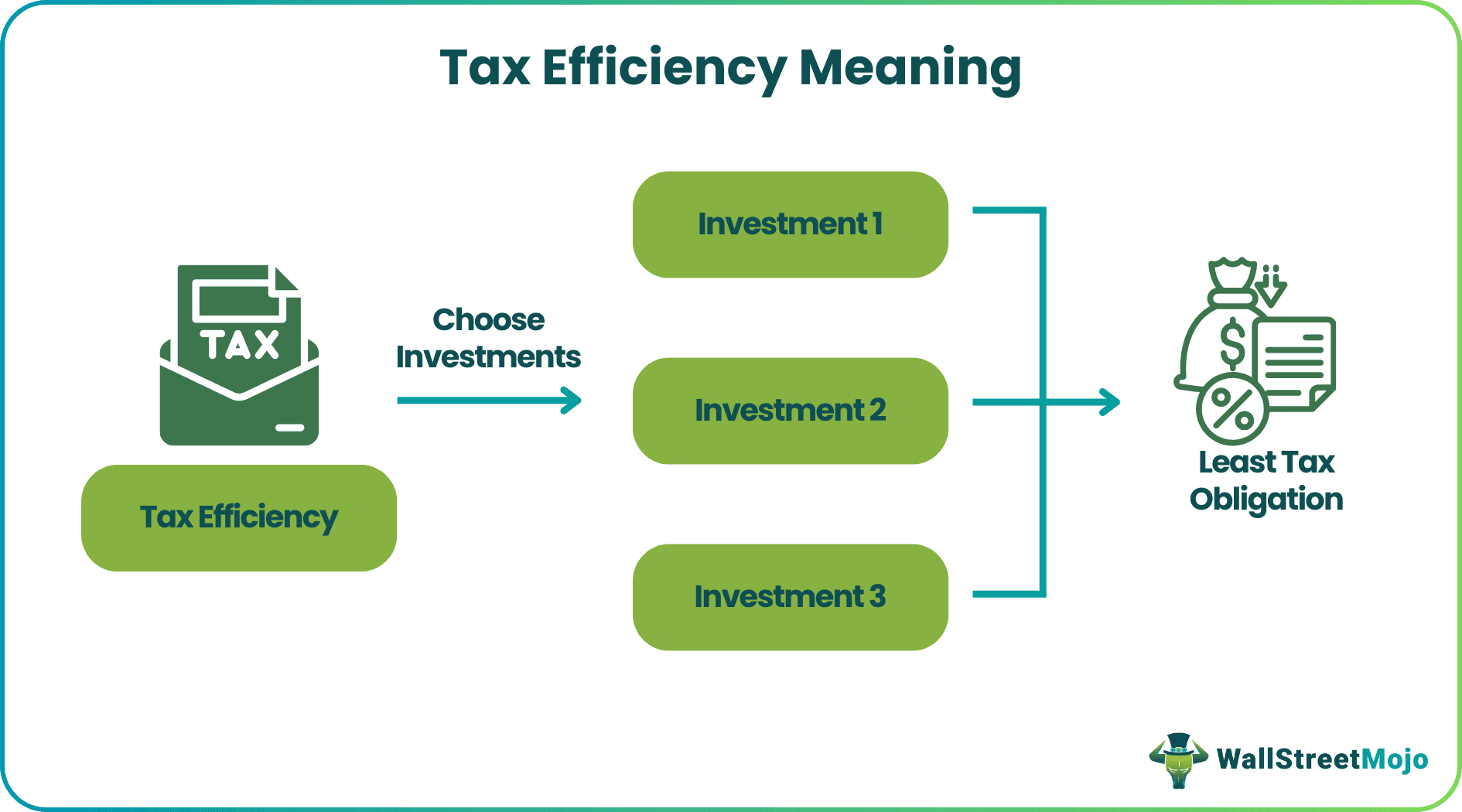Table Of Contents
What Is Tax Efficiency?
Tax efficiency can be defined as the process of paying the least possible amount of tax. It can also be referred to as the organization or management of investments in such a way as to receive minimum taxation on them. Examples of such investments include mutual funds, bonds, etc.

Tax efficiency is significant as any taxpayer would wish to pay the minimum possible amount as tax. And especially when it comes to investing, individuals would have to pay a part of their returns as tax earned on the income. Hence, investors would prefer tax-efficient investments.
Key Takeaways
- Tax efficiency can be referred to as the process of maintaining securities or assets that minimize the tax burden for an investor.
- Generally, investments that offer high turnover or returns are considered less tax efficient, whereas those which offer low returns are highly tax-efficient.
- Investors can minimize their tax in many ways – by investing in tax-efficient funds or opening a tax-deferred income-producing account.
- The tax efficiency ratio is given as (Returns from an investment – Tax paid/ Returns from the investment) x 100
- Apart from investors, businesses and individuals also seek income tax efficiency.
Tax Efficiency in Investing Explained
Tax efficiency in investing is an important concept. It is legally essential that tax be paid on any income earned by an individual. Therefore, every investor has a tax obligation when receiving securities returns. This goes against their motive for investing, which is to make profits or secondary income. Hence, this is where tax-efficient funds can help them.
Consider a mutual fund that can give an investor $100 returns. If the investor has to pay $20 as taxes on the investment, the net returns would only be $80. However, suppose the investor was to choose a tax-efficient mutual fund that gave returns of $90 and only carried a tax burden of $5. The net returns would be $85. Consequently, the second investment would be more profitable for the investor.
Therefore, an investor should be careful while making investment decisions because tax-efficient funds can be advantageous. Further, investments that generate higher returns are likelier to have less income tax efficiency. This can be due to capital gains and high dividend payments. Conversely, low-return investments have less tax burden. Especially consider the example of municipal bonds, which carry zero tax burden and low but assured returns.
The most obvious way would be to choose a tax-efficient investment over a normal one. For example, comparing the tax efficiency of mutual funds rather than just looking at the expected returns they can generate in a particular period can help in the long run. A second option would be to open a tax-deferred income-producing account. Finally, an individual retirement account (IRA) or a 401(k) plan can be helpful.
Formula
The tax efficiency ratio, or the tax management efficiency ratio, is a popular measure that explains which assets can be tax-efficient. Hence, this allows investors to select investments based on their potential tax savings.
One can calculate the ratio as follows:
(Returns from an investment – Tax paid/ Returns from the investment) x 100
Hence, the tax management efficiency ratio measures the tax obligation on a particular asset as a percentage of the earnings.
A higher ratio indicates that the investment will be highly tax-efficient and will save more tax for the investor.
Calculation Example
Robert is an investor. He buys a bond for $50. The expected earnings and the tax owed on the bond are $12 and $3, respectively. Calculate the tax efficiency of the bond.
Tax management efficiency ratio = (Expected returns after tax/ Expected total returns) x 100
= (9/ 12) x 100
= 75%
Hence, the bond is 75% efficient.
Tax Efficiency Of Mutual Funds vs ETF Investments
Here, the investor has to understand two aspects – capital gain and dividends. Capital gain refers to the appreciation of the value of an asset. This is usually realized when the investment is sold. Therefore, capital gains, too, are subject to taxation, known as the capital gains tax.
Earlier this year, CNBC reported that American taxpayers paid more than $500 billion in 2022, compared to $250 billion the previous year. And according to the estimations, most of this was through the capital gains tax. But an investor can only be taxed in such a way when they hold an investment for more than a year. However, capital gains from an exchange-traded fund are relatively rare.
Secondly, dividend payments from the investments need to pay taxes too. But dividends are of two types – ordinary and qualified. Ordinary dividends are paid directly by the mutual fund or ETF and are taxed at the normal income tax rate. Qualified dividends are paid when a stock is held for a minimum period, known as the holding period. Qualified dividends are usually taxed at the lower capital gains tax.
Now, considering the tax efficiency of mutual funds and ETFs, the latter is considered more tax-efficient than the former. This is because of the structuring of the ETFs that use creation units to facilitate the buying and selling of funds. Another reason is the fewer transactions in an ETF, which occur only when the underlying index changes. Further, mutual funds give more capital gains than ETFs, making them more subject to taxation.
